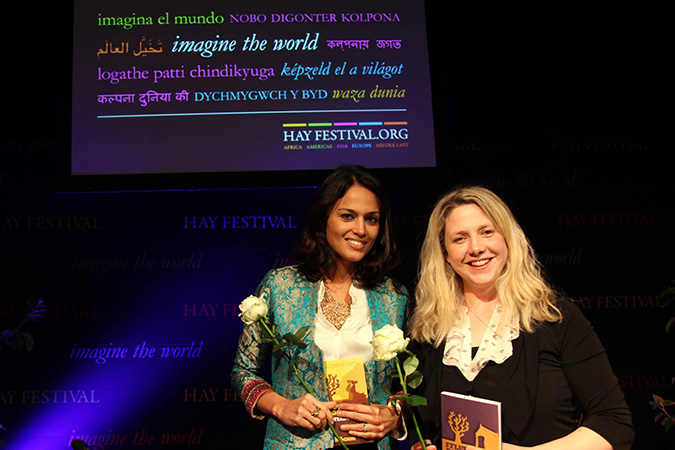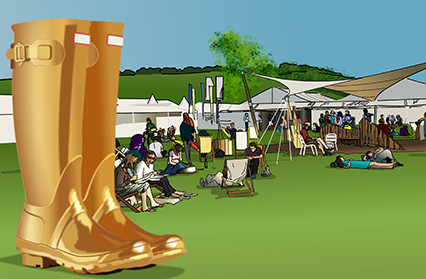Fflur Dafydd and Samanta Schweblin, Wales/Argentina, with Daniel Hahn, 27 May
Tishani Doshi and Fflur Dafydd, The Women of the Mabinogion, 27 May

Photo by Oliver Bullough
Fflur Dafydd’s writing career was, she told me at Hay, ricocheted forward by her inclusion in Scritture Giovani in 2005, following the publication of her first novel that year. This is a project aimed at promoting young writers in a collaboration between the Hay Festival in the UK, Festivaletteratura in Mantua, Italy and the Internationales Literaturfestival Berlin. Fflur has gone on to win many awards, and is the current International Hay Fellow, a position which has already taken her to the Hay festivals in Segovia, Mexico, Norway and Cartagena, with more to come. She seems to thrive on the international festival scene, and is also accustomed to being in the spotlight as a singer/songwriter. Plus she is now embarking on film-making career too as screenwriter and co-producer of the film adaptation of her novel Y Llyfrgell (The Library).
Fflur writes in both Welsh and English. Welsh is her first language, and the one in which she says she always tells her stories first. In discussion with the Argentinian writer Samanta Schweblin, and Daniel Hahn, national programme director of the British Centre for Literary Translation, she spoke about the difference for her between writing in English and Welsh. Her intimate, instinctive relationship with her first language enables her, she said, to bring to her writing in English an awareness of having another language and identity, and she finds she can write about Welsh identity in a new and fresh way in English.
Her novel Twenty Thousand Saints started out as a translation of Atyniad, the short novel with which she won the Prose Medal at the National Eisteddfod of Wales in that year. But it grew to be a bigger book in which she had more to say. She describes the books as cousins, members of the same family but with different characteristics.
Fflur and Samanta spoke about the short story form, its challenges to the writer to use restraint and economy of language, and of how to deal with the fragmentary nature of stories in a collection. Fflur made a fascinating comparison with the compilation of an album of songs – the choice of the title story, the need to pack a punch with the piece which is number four or five, and a letting go with the final piece.
Frustratingly for those unable to read Welsh, there has so far been little opportunity to read much by either writer in short form in English, so the extracts we heard of their stories were tantalising tasters. Fflur read the beginning of her story ‘The Nest in Your Hair’ (due to be published in a collection in 2015) in both languages. Daniel read Samanta’s story ‘To Kill a Dog’ in English and raised the question of whether a story, translated by another person, is still the original author’s story? I am not sure that she gave a clear answer, or whether it was lost in translation, good as her interpreter was!
*
Later the same day at Hay I heard Fflur Dafydd talking with Tishani Doshi about their respective contributions to the Seren series of re-imaginings of stories from the Mabinogion: Fflur’s ‘The White Trail’ (2011) and Tishani’s ‘Fountainville’ (2013). The two women had an easy rapport which made this session feel a lot more relaxed than the earlier one. I do wonder whether sometimes having a chairperson/interviewer at Hay can get in the way rather than facilitating the flow of conversation, though I recognise that it may be necessary where there are two languages being spoken. No such issue in this session, and definitely no need for an intermediary. Tishani – born in Madras to a Welsh mother and Gujarati father – admitted to nervousness in tackling the commission as she had not grown up with the stories of the Mabinogion, but said that she found in practice that the constraints of using an existing story actually gave her a freedom to explore different ways of telling it.
I think that Fflur Dafydd is Renaissance Woman, adding her interviewing skills to her already-impressive panoply. And, as a writer who is also a singer talking with a writer who is also a dancer, she was able to raise issues of performance, of timing, rhythm and energy in the story (re)telling which which they had both engaged in this project. They talked about links between magic realism and myth and the crazy things in both, about insider-outsider relationships, about the demands of condensing an epic tale into a novella.
In practice, this was not so much a discussion about the women in the Mabinogion stories, as one about women writers exploring what they can bring to tales which have been told before; new ways of storytelling for new generations. These old stories are precious and multi-layered, but their dense plots can be off-putting to new readers. I came out of this session wanting to read these two stories and more by their respective authors, and to me, that is what Hay is all about, discovering new writers and unexpected treasures. The Big Names may draw the big crowds, and many people will continue to go to Hay for that, but the smaller venues hold delights too, and long may they have their place in the festival.
Illustration by Dean Lewis



 Enjoyed this article? Support our writers directly by buying them a coffee and clicking this link.
Enjoyed this article? Support our writers directly by buying them a coffee and clicking this link.








